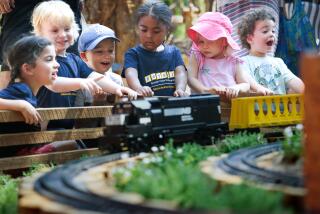4 Methods of Sculpting Creatures in Your Garden
- Share via
The home gardener can undertake any of the four types of topiary but should realize that the art takes imagination--and patience.
The simplest method is free form, which involves no support structure.
“Free form relies solely on the creativity of the gardener trimming the plant,” said Disneyland’s Ken Inouye. Outside It’s a Small World, some of the shrubs are carved into geometric shapes, such as boxes and spheres.
In European gardens, several shapes are sometimes incorporated on the same plant, such as cones, squares and triangles.
Anybody who trims hedges is engaging in elementary topiary. It just depends on how fancy you want to get. With a little artistic effort, a pair of hedge clippers can turn a bush into the Sphinx.
“Ficus is good for free form,” Inouye said, but fast-growing eugenia can also be used.
Perhaps the most dramatic example of free-form topiary is the Japanese art of bonsai, in which such specimens as juniper are trimmed and pinched to resemble miniature mature trees.
The second method, and the one used for the largest topiary figures, is to grow a plant within a superstructure of reinforced iron rebar.
The half-inch-thick bars are twisted, cut and fused into the skeletal image of an animal. “You need a very talented welder,” Inouye said.
The structure is then placed in a large box or in the ground with a shrub or tree under it. It takes at least five to seven years for this type of topiary, and it can take up to 10 years to grow enough foliage to fill out a 5-foot-tall structure.
For faster results, an already-mature tree can be bent to conform to the skeleton, but this is tricky and must be done carefully to avoid breaking the branches.
In Disneyland’s back lot, an olive tree is taking the form of a majestic swan inside its rebar skeleton. At four years old, it has five more years to go before it is presentable to park visitors, Inouye said. Standing naked, awaiting its foliage, is a crocodile upright on two legs. It is one of several creatures planned for Disneyland’s new Critter Country (formerly Bear Country), which also includes a formidable mountain lion and a skunk with its tail in the air.
The third topiary method incorporates what Inouye calls “a different philosophy.” Instead of providing a hard, skeletal base that will stay with the plant, a chicken wire or hog wire form is fashioned like a crustacean shell, with the plant growing completely inside. When the leaves emerge to cover the wire, it is time to cut the wire away. After that, it is just a matter of trimming, free-form style, to keep the shape of the animal.
Several Disneyland creatures are being sculpted this way, including a Roger Rabbit and a Mary Poppins--complete with suitcase and umbrella. Actually, Mary is a combination; the hog wire holds the eugenia in the main shape and suitcase, and the umbrella is made of rebar. Inouye said another plant will probably be used to fashion the umbrella.
If the figure is small, the artist can use chicken wire, which is very thin wire in hexagonal shapes. Hog wire, which is the same as chicken wire only with larger hexagons, is used for bigger figures. Supplementary wire can be used to extend or strengthen shapes, but Inouye warned against using any copper wire, which poisons the plants.
The fourth type of topiary is similar to the third in that an outer shape is made from chicken wire. But inside the wire is a stuffing composed of spagnum moss, into which a plant or vine is inserted. The moss serves as a solid base and nutrient source, and the plant covers it almost the way fur covers an animal.
The result is a spongy, solid structure.
Inouye noted that unlike Disneyland, Disney World in Florida has a large collection of these types of structures because the Florida climate is more suited for them. But he is experimenting with several of them inside a greenhouse. A Mickey Mouse composed of ficus repens, which is a vine or bedding plant, is slowly growing amid some spagnum moss on a worktable. Another Roger Rabbit resides on the floor.
Growing the vines is not difficult, Inouye said. You just wet the spagnum moss, stuff it into the shape, insert the vines and tie up the holes with other wire. Nurseries rarely carry chicken and hog wire, but hardware stores do.
Sculpting the wire shape is the biggest hurdle.
“The hardest thing to furnish is the creativity and the imagination,” Inouye said. “Fortunately, we have employees who are extremely talented.”






